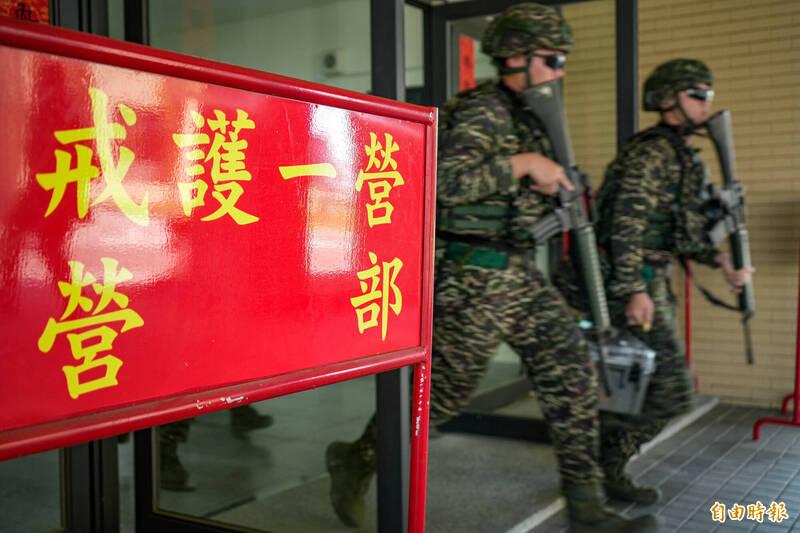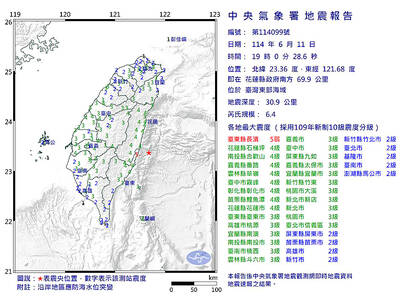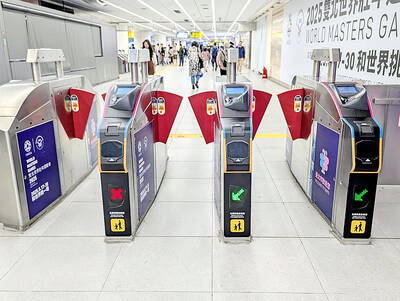Shifting from primarily offensive capabilities to a hybrid offensive-defensive force, the marine corps is establishing new land and sea-based units to defend missile and radar crews, local outlets reported today.
The marine corps established the land-based “Air Defense Guard Group, First Security Battalion” on Nov. 14 last year, composed mainly of one-year conscripts, to safeguard mobile missile and radar units, enhancing battlefield security.
As part of this strategic shift, the marine corps was reported as saying it had disbanded M60A3 tank battalions and M109A2 self-propelled artillery battalions, while establishing a drone battalion.

Photo: Liu Yu-chieh, Taipei Times
In addition, to strengthen the defense of political and economic centers, the Marine 66th Brigade has been reassigned to the strategic reserve force and deployed to key infrastructure locations such as Taipei International Airport (Songshan airport), it said.
Maritime security would be carried out by a special unit, trained for both land and sea operations, the marine corps said.
This unit would support amphibious landings, provide reconnaissance and security during ground operations and help protect the flanks of military forces, it said.
In peacetime, it would also work with government agencies on counterterrorism and disaster response, it added.
The corps said that the M109 special assault boat, due to its high mobility and firepower, can effectively deal with nearby enemies during coastal water defense operations, ensuring mine-laying missions are successfully completed.
Besides this, the marine unit’s role would be adjusted in response to the upcoming establishment of the navy’s Coastal Operations Command, the military said.
First Security Battalion Commander Kuo Shih-yu (郭詩玉) said that all security tasks require the use of vehicles, so team personnel, mainly one-year conscripts, must have basic driving and vehicle troubleshooting skills.
More sophisticated equipment would mainly be operated by battalion officers, Kuo said.
Su Tzu-yun (蘇紫雲), a research fellow at the Institute for National Defense and Security Research, said that establishing these security battalions reflects important strategic changes in the military that extend beyond the marine corps to the army, navy and air force.
For example, the navy is developing an underwater fleet using domestically produced submarines and establishing a Coastal Operations Command next year to strengthen its land-based combat capabilities, Su said.
The marine corps has taken on a hybrid offensive and defensive role, changing the numbers and types of vehicles used to respond to conflicts and armed threats, he said.
Its main force would be positioned on Taiwan proper to rapidly respond to any threats, he said.
This strategic shift aligns with the US Marines’ decision to abandon tank battalions and strengthens Taiwan’s overall defense, he said.
In the future, the marine corps would be a security force and strategic reserve, working alongside the army and military police in different defense zones, taking on the role of “guerrilla fighters,” Su said.
Jiang Hsin-biao (江炘杓), an assistant researcher at the institute and retired navy captain, said that the marine corps should establish new types of combat capabilities, such as utilizing drones and anti-drone systems, for effective security roles.
Regarding maritime security, Jiang said that since the greatest threat to mine-laying boats comes from the sky, it is necessary to strengthen air defense capabilities.

A magnitude 6.4 earthquake struck off the coast of Hualien County in eastern Taiwan at 7pm yesterday, the Central Weather Administration (CWA) said. The epicenter of the temblor was at sea, about 69.9km south of Hualien County Hall, at a depth of 30.9km, it said. There were no immediate reports of damage resulting from the quake. The earthquake’s intensity, which gauges the actual effect of a temblor, was highest in Taitung County’s Changbin Township (長濱), where it measured 5 on Taiwan’s seven-tier intensity scale. The quake also measured an intensity of 4 in Hualien, Nantou, Chiayi, Yunlin, Changhua and Miaoli counties, as well as

Credit departments of farmers’ and fishers’ associations blocked a total of more than NT$180 million (US$6.01 million) from being lost to scams last year, National Police Agency (NPA) data showed. The Agricultural Finance Agency (AFA) said last week that staff of farmers’ and fishers’ associations’ credit departments are required to implement fraud prevention measures when they serve clients at the counter. They would ask clients about personal financial management activities whenever they suspect there might be a fraud situation, and would immediately report the incident to local authorities, which would send police officers to the site to help, it said. NPA data showed

ENERGY RESILIENCE: Although Alaska is open for investments, Taiwan is sourcing its gas from the Middle East, and the sea routes carry risks, Ho Cheng-hui said US government officials’ high-profile reception of a Taiwanese representative at the Alaska Sustainable Energy Conference indicated the emergence of an Indo-Pacific energy resilience alliance, an academic said. Presidential Office Secretary-General Pan Men-an (潘孟安) attended the conference in Alaska on Thursday last week at the invitation of the US government. Pan visited oil and gas facilities with senior US officials, including US Secretary of the Interior Doug Burgum, US Secretary of Energy Chris Wright, Alaska Governor Mike Dunleavy and US Senator Daniel Sullivan. Pan attending the conference on behalf of President William Lai (賴清德) shows a significant elevation in diplomatic representation,

The Taipei MRT is to begin accepting mobile payment services in the fall, Taipei Rapid Transit Corp said on Saturday. When the company finishes the installation of new payment units at ticketing gates in October, MRT passengers can use credit cards, Apple Pay, Google Pay and Samsung Pay, the operator said. In addition, the MRT would also provide QR payment codes — which would be compatible with Line Pay, Jkopay, iPass Money, PXPay Plus, EasyWallet, iCash Pay, Taiwan Pay and Taishin Pay — to access the railway system. Currently, passengers can access the Taipei MRT by buying a single-journey token or using EasyCard,